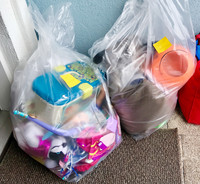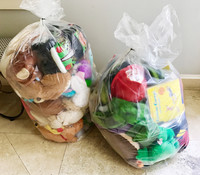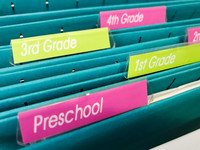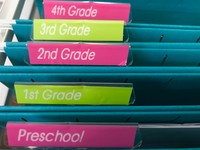



The 2017-2018 school year is coming to a close. That ultra-organized first day of school house has been replaced by rooms of outgrown toys, worn-out clothes, piles of school papers and dirty backpacks amid Legos and hair ties. Here are some tips to get you back on the organized track.
Start early
The day after my daughter’s last day of second grade, a clean-up and reorganization of her room turned up missing school text books, gym clothes and library books. Off I went to her school, sheepishly returning those items we’d missed. The organization process needed to start sooner!
Let children downsize
So, where to start? Should you shuttle your child off to a sleepover, so you can gut their room solo? Do you give them a large trash bag, an ultimatum and leave them to it?
Organizing is a life skill and life skills can be taught. One mother I helped wanted to clean out her 5-year-old’s room. I suggested we involve her daughter - I’ll call her Sara - in some of the decisions. We played a game of “Keep or Give,” and after an initial flurry of “keeps,” Sara’s “gives” soon filled two large bags with “stuffies” and toys to pass on to other children. We took a photo of a beaming Sara standing proudly next to her donations.
In another case, a 9-year-old boy with a mop of red hair stood guardedly at the door to his room. The floor was covered with motorized toy cars, “stuffies” and action figures.
“Don’t judge me,” he admonished.
I assured him I wouldn’t, and the purging began. He soon filled several boxes of toys he’d outgrown, much to his mother’s surprise (and a little wistfulness).
Even young children can help weed out at least some of their belongings. Your child might surprise you with the things they are ready to part with.
Curate like the Louvre
According to The Oxford Dictionary, the definition of curate is to select, organize, and look after the items in a collection or exhibition.
Museums select and preserve art that best represents an artist. Likewise, you should selectively cull your child’s accumulated paper and artwork. Don’t saddle them (or yourself) with stacks of boxes to sift through decades from now. They will most likely sit in another dusty attic for years.
Why not select your child’s top five masterpieces from first grade? Save the one perfect watercolor handprint and discard all the practice runs with missing fingers. Keep meaningful and significant awards certificates. You may wish to store report cards in a separate “school records” folder.
Guilt, guilt, guilt
Discarding your child’s creations can be painful if there is an emotional attachment. Having trouble letting go? Ask yourself these questions out loud:
Hearing your own thought processes can help speed up decision-making.
Containerize
Once you’ve whittled down to the very best, select the smallest storage container needed. Make a file for each grade and store these in a file box, one per child. Attach a school photo to the outside for a special touch! Hanging pocket folders (enclosed on the sides) will ensure nothing small falls out. Here are other storage ideas:
End of school countdown!
Don’t let your child’s performance fizzle out as the semester draws to a close. Discuss and clarify any remaining assignments so there are no nasty surprises. Gather books that need to be returned to school. Check lost and found for any missing items.
When that last day finally rolls around, find a way to celebrate! I know a mother and daughter who share a tradition of a homework bonfire, eliminating practically all of the year’s paper! However you downsize the school year, you will have to save one thing: the infamous summer reading list!
Barbara Trapp is a professional organizer serving Northeast Florida. For more information, visit zenyourden.com or contact her via info@zenyourden.com or (904) 500-7678.